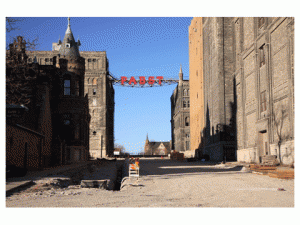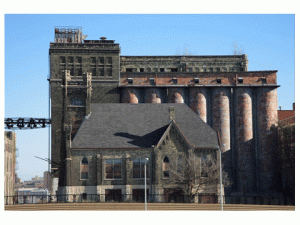
USGBC published a new guide called “LEED for Neighborhood Development and Historic Preservation” on their website March 5th, 2013.
Since 2009, LEED Neighborhood Development (ND) has been paving the way for the integration of historic preservation principles into the LEED rating systems. LEED-ND 2009 was the first of the many LEED rating systems to incorporate language regarding historic preservation laws and practices into the credits. Last week LEED-ND continued its leadership by being the first rating system to create and post historic preservation guidelines on the USGBC website.
The 13-page document has been in the works since the summer, and while it does not provide any groundbreaking new insight into the topic, what USGBC does do is start to formalize what many of us practicing in this area have known for a long time – sustainability and preservation principles are complementary, and LEED and historic preservation can work well together. And while the preservation camp has been saying it for years, USGBC is now officially saying it too.
What is LEED-ND?

The historic Pabst Brewery in Milwaukee is being adaptively reused and is a LEED ND certified project. Photo courtesy Pabst Brewery.
LEED Neighborhood Development is unique among the LEED rating systems in that it was created as a partnership of three organizations – The Congress for New Urbanism, Natural Resources Defense Council and USGBC. It integrates the principles of smart growth, new urbanism and green building into a national system for neighborhood planning and design. Originally developed specifically for new neighborhoods, almost immediately existing neighborhoods started registering for it as well. There has been discussion about ultimately creating a LEED-ND specifically for historic or existing neighborhoods, but in the meantime this is the rating system which has pioneered the use of preservation language and approaches, and has set the stage for the edits to the rest of the rating systems in Version 4. I wrote a summary of LEED ND 2009 in 2008 for Preservationnation.org, which still holds up pretty well and I encourage you to read that overview before you read this new guide.
LEED for Neighborhood Development and Historic Preservation
This guidance document outlines the synergies between the LEED for Neighborhood Development rating system and preservation of historic resources. It is intended both for sustainable development project teams interested in learning how to incorporate historic buildings into their projects and preservationists looking to rehabilitate a landmark in a sustainable way. It shows where the goals of green building and historic preservation overlap and explains in detail the ways, some obvious and some nuanced, that LEED-ND encourages historic preservation.

First German Methodist Church, the Malt Elevator & the Malt House at the Pabst Brewery, a LEED ND certified project. Photo courtesy Pabst Brewery.
With sections called “Historic Preservation Is Inherently Green,” “Using LEED ND as a Tool for Historic Preservation,” “Achieving LEED-ND Credits for Historic Preservation,” and “A Nuanced Approach to Historic Preservation Using the LEED-ND Rating System,” this short set of guidelines identifies the credits that are directly related to preservation (green infrastructure building credits), those in which historic buildings provide an advantage over new construction (sites in urban cores for example) and those in which exemptions are provided for historic buildings (walkable streets). The guidelines conclude with three case studies: the adaptive use of a brewery complex in downtown Milwaukee (LEED Platinum), a historic neighborhood in Syracuse called the SALT district which uses incremental rehabilitation of residential properties to create artist havens (LEED Gold) and a mixed use development at the Currie Barracks in Calgary, Alberta, which includes both historic buildings and cultural landscapes (LEED Gold).
USGBC concludes the guide with “the LEED for Neighborhood Development rating system encourages project teams to achieve these goals by redeveloping historic sites, creating continuity for neighborhoods that celebrate the past while preparing for the future.” What these case studies and the guide demonstrate is that the use of green building analysis tools in conjunction with preservation methodologies can lead to a plan for efficient environmental actions that improve long term stewardship, and will show how new technologies and acknowledgment and reactivation of original design features can together provide innovations in green building design while debunking the myths that historic buildings, neighborhoods and landscapes cannot readily achieve LEED certification.
Note: The sixth public comment period for the final version of LEED v4 is open for comments until March 31st. Stay tuned for a review of this latest version in next week’s blog.
And if you’d like to “subscribe” or follow my blog, True Green Cities, please sign up through the “Subscribe” button at the bottom left of this page. You’ll receive a daily recap when new blogs are posted. Or Sign up for the Feed.

